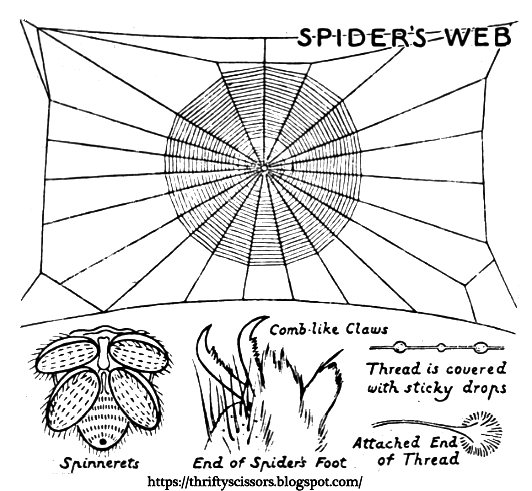 |
| Argiope aurantia |
Required for Web Observation: Diagram of a garden spider's web, and an illustration showing the nature of the spinnerets. Bird-lime. The children should examine the web of the garden spider; and, if possible, watch the spider while in the act of constructing it.
Method of Student Web Observation:
- Call attention to the regular geometric pattern of the web, noting that the outer threads, which form the foundation of the web, are necessarily irregular, on account of the disposition of the convenient points of support.
- Exhibit a diagram of the spinnerets of the garden spider, showing the manner in which the fibers unite to form a single thread. Give examples of other sticky substances, such as bird-lime and thick molasses. Show that bird-lime can be drawn out into very fine fibres, and that these fibers may be made to unite into one.
- The children should watch the construction of the web if possible. If this cannot be done, the teacher should build up a diagram of the web on a black-board, making the various threads in their proper order.
- The sticky nature of the spiral thread should be demonstrated.
How to Grade Study Notes For Student Journals: Every student will need a journal to write in weekly for this online nature study series. Teacher will assign the weekly content in advance.
- Make sure the facts are: written in complete sentences, the first word of each sentence capitalized, and a period should be included at the end of each sentence.
- Spell check your vocabulary and write the words correctly.
- Dress up your journal entries with student clip art, drawings of your own in color or in black and white.
- Student may also include photographs of their own taking for extra credit.
Look for the following three facts about webs inside of student journals. Assign a point value to the quality of the content:
- The Web. - The web is attached to bushes, palings, or other objects by several outer threads more or less irregularly disposed. Radiating threads pass from the center of the web to the above. Lastly, a spiral thread connects all the radiating ones.
- The Spinning Organs. - The spinning organs of the garden spider are termed spinnerets. They are situated at the tip of the abdomen, and are six in number. Each consists of a little cell of sticky fluid, and the under surface of the cell is perforated with numerous small holes. When the spider applies its spinnerets to any object the sticky fluid adheresto that object ; and, as the abdomen is withdrawn, a very thin semi-fluid fiber is produced from each perforation of the spinneret. All the fibers formed by each spinneret unite, while still fluid, to form one. Thus six threads are formed, one for each spinneret, and these again unite into one. The sticky fluid then hardens, forming a single thread of silk.
- Building the Web. - Various foundation threads are first made. These connect the convenient points of support. The radiating threads are next formed. The spiral thread is next formed, beginning at the center. The spider makes use of its comb-like hind-claws in adjusting and uniting the various threads. Both the outer and the radiating threads are forsupport only ; and the spiral thread, which has numerous little globules of a sticky fluid that does not readily solidify on exposure to air, forms the snare proper.
Video at Youtube for Students to Watch:
- Animal for Kids: the spider by All Things Animal
- Is a spider's web a part of its mind? by Deep Look
- Why spider silk is stronger than steel
- Spider web research yields...a new musical instrument by Oregon Public Broadcasting
- 15 cool spider webs by Top Fives
Hold a group discussion after viewing a film or on the second day of study. Prompt the students to mention/remember the following information about webs.
- The Web. - The outer threads support the web. Other threads meet in the center and are joined by a spiral thread.
- Spinnerets. - The spinnerets are cells containing a sticky fluid. This fluid passes out through small holes. All the fibers unite into one thread.
- Building the Web. - The outer threads are spun first. Then those which meet at the center. The spiral thread is formed last. The spiral thread has sticky drops on it.
The student art assignments available on this blog for webs: 1rst-6th Grades
- Draw a shaded white spider web design - 5th and 6th grades
- Draw a design from a spider's web using glue and pastels - 3rd and 4th grade
- Craft a Ruote pasta web - 1rst and 2nd grade
- Weave a spider's web for a spooky Fall craft... - 3rd and 4th grade
Extended Learning Content:
- How to cut paper spider webs...
- Craft a ''Boo'' spider web wreath for your dollhouse
- Decorate a fall pumpkin with a spider web vine
- The Cobweb Poem
Free Student Clip Art: Clip art may be printed from a home computer, a classroom computer or from a computer at a library and/or a local printing service provider. This may be done from multiple locations as needed because our education blog is online and available to the general public.
 |
| Above are illustrations of: spinnerets, spider's web, end of spider's foot, comb-like claws, thread covered with sticky drops, attached end of thread. |


No comments:
Post a Comment
Folks, thanks for comments. These are all checked out before publishing. I can not publish spam, doing this negatively reflects upon 'how' my blog ranks and it also will make you look suspicious to those who own this software.
Note: Only a member of this blog may post a comment.